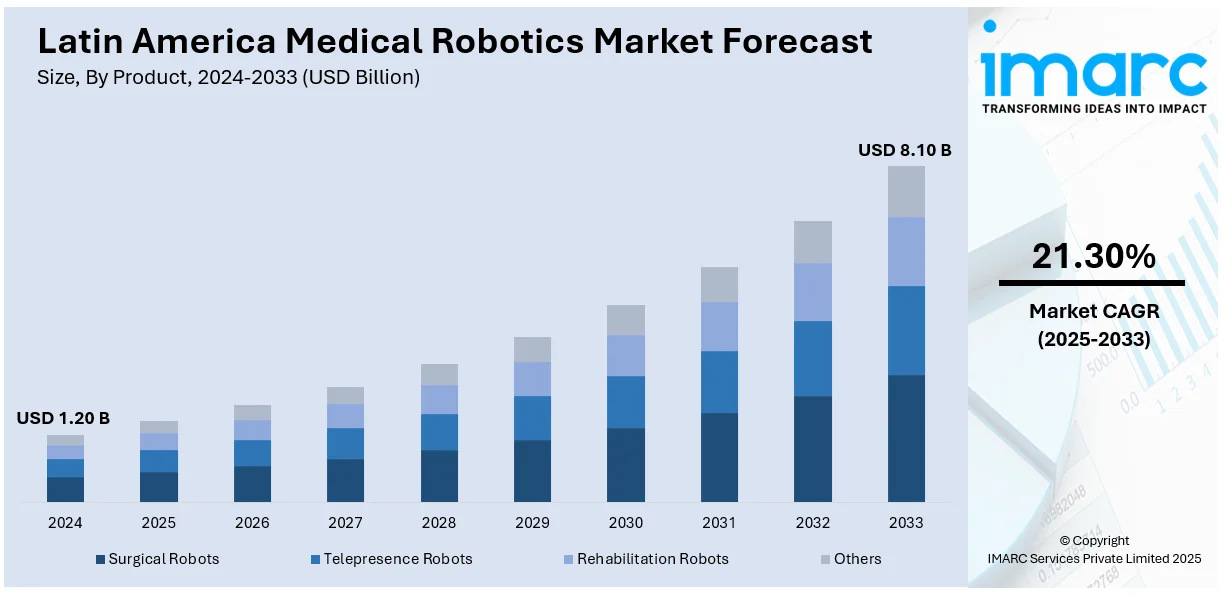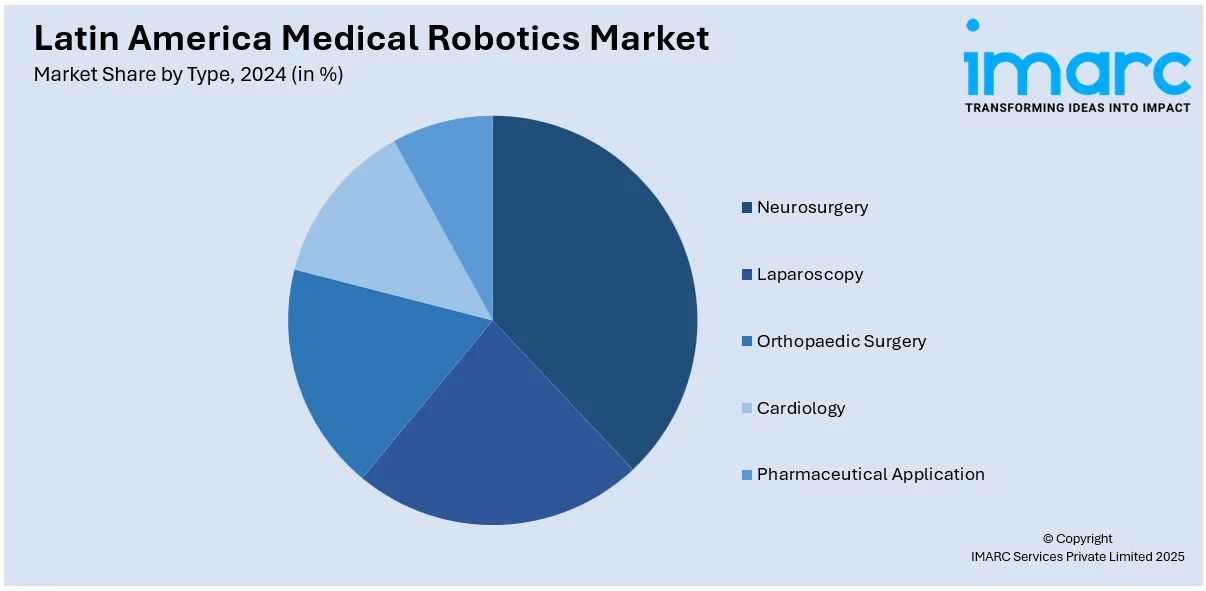
Latin America Medical Robotics Market Size, Share, Trends and Forecast by Product, Type, and Region, 2025-2033
Latin America Medical Robotics Market Overview:
The Latin America medical robotics market size reached USD 1.20 Billion in 2024. Looking forward, IMARC Group expects the market to reach USD 8.10 Billion by 2033, exhibiting a growth rate (CAGR) of 21.30% during 2025-2033. The increasing demand for minimally invasive surgeries, rising healthcare expenditure, advancements in AI and robotics, a growing aging population, expanding hospital infrastructure, technological innovations, and increasing adoption of robotic-assisted procedures across the region significantly expanding the Latin America medical robotics market share.
|
Report Attribute
|
Key Statistics
|
|---|---|
|
Base Year
|
2024
|
|
Forecast Years
|
2025-2033
|
|
Historical Years
|
2019-2024
|
| Market Size in 2024 | USD 1.20 Billion |
| Market Forecast in 2033 | USD 8.10 Billion |
| Market Growth Rate (2025-2033) | 21.30% |
Latin America Medical Robotics Market Trends:
Rising Adoption of Surgical Robotics in Healthcare Facilities
Growth of the Latin America medical robotics market is fueled by the growing use of robot-assisted surgery in hospitals and specialty clinics. Demand for minimally invasive procedures is spurring the use of surgical robotics, improving accuracy, cutting down on recovery times, and limiting surgical complications. Brazil and Mexico are among the leading nations in adopting such a trend, with top health institutions investing in sophisticated robotic systems. The increasing rate of chronic diseases, including cardiovascular disease and cancer, has further surged the demand for robotics in surgeries. Moreover, doctors are receiving specialized training to handle these machines effectively, thus driving market growth. For instance, as of September 2024, Medu AI has transformed medical education with the use of cutting-edge artificial intelligence into its educational platforms. In order to provide AI-powered resources that improve medical education, the company works with medical experts and organizations in Mexico and Panama. These resources successfully close the gap between theoretical knowledge and real-world application by providing individualized learning experiences that include interactive simulations and real-time feedback. With global medical robotics companies forming partnerships with regional healthcare providers, Latin America is expected to experience a surge in robotic-assisted surgeries. The continued technological advancements and cost reductions in robotic solutions will further solidify the region's position in the global medical robotics landscape.

Growth of AI-Powered Robotics for Rehabilitation and Patient Assistance
The integration of artificial intelligence (AI) in medical robotics is transforming patient rehabilitation and assistance in Latin America. AI-driven robotic systems are being increasingly utilized in physical therapy centers to support patients recovering from strokes, spinal cord injuries, and musculoskeletal disorders. These robotic-assisted rehabilitation devices provide personalized therapy sessions, track patient progress in real time, and adjust treatment plans accordingly. The rising elderly population in countries such as Argentina and Chile is further driving demand for robotic solutions that assist in mobility and daily activities. For instance, according to a June 2024 study by the Economic Commission for Latin America and the Caribbean (ECLAC), which addressed the demographic shift in the region, there will be 94.9 million people in the region who are 60 years of age or older, or 14.2% of the total population in 2024. By 2050, that number is predicted to rise to 25%. Additionally, AI-powered robotic exoskeletons are enabling paraplegic patients to regain movement, enhancing their quality of life, which in turn is positively impacting the Latin America medical robotics market outlook. Governments and private healthcare organizations are investing in AI-driven robotic rehabilitation programs, making advanced patient care more accessible. As AI continues to evolve, the efficiency and capabilities of robotic rehabilitation systems will improve, making them an essential component of Latin America’s medical robotics ecosystem.
Latin America Medical Robotics Market Segmentation:
IMARC Group provides an analysis of the key trends in each segment of the market, along with forecasts at the regional level for 2025-2033. Our report has categorized the market based on product and type.
Product Insights:
- Surgical Robots
- Telepresence Robots
- Rehabilitation Robots
- Others
The report has provided a detailed breakup and analysis of the market based on the product. This includes surgical robots, telepresence robots, rehabilitation robots, and others.
Type Insights:

- Neurosurgery
- Laparoscopy
- Orthopaedic Surgery
- Cardiology
- Pharmaceutical Application
A detailed breakup and analysis of the market based on the type have also been provided in the report. This includes neurosurgery, laparoscopy, orthopaedic surgery, cardiology, and pharmaceutical application.
Regional Insights:
- Brazil
- Mexico
- Argentina
- Colombia
- Chile
- Peru
- Others
The report has also provided a comprehensive analysis of all the major regional markets, which include Brazil, Mexico, Argentina, Colombia, Chile, Peru, and others.
Competitive Landscape:
The market research report has also provided a comprehensive analysis of the competitive landscape. Competitive analysis such as market structure, key player positioning, top winning strategies, competitive dashboard, and company evaluation quadrant has been covered in the report. Also, detailed profiles of all major companies have been provided.
Latin America Medical Robotics Market News:
- On October 21, 2024, the emergency department at Skyline Hospital announced that it will be acquiring a cutting-edge stroke robot to improve patient care. Real-time, remote consultations with neurologists are made possible by this cutting-edge technology, which speeds up the evaluation and treatment of stroke victims. It is anticipated that by cutting down on the time needed for diagnosis and action, the integration of this system will greatly enhance patient outcomes.
- On November 4, 2024, Presbyterian Santa Fe Medical Center (SFMC) announced that it has acquired the da Vinci XI, a cutting-edge robotic technology for minimally invasive surgery. With the use of three robotic arms and a 10x magnification camera, this technology allows surgeons to execute precise surgeries, producing incisions that are smaller than a cent or dime. With ambitions to expand into urology in 2025, SFMC expects to perform about 360 robotic-assisted treatments in the first year, first concentrating on specialties including colorectal surgery, general surgery, and urogynecology.
Latin America Medical Robotics Market Report Coverage:
| Report Features | Details |
|---|---|
| Base Year of the Analysis | 2024 |
| Historical Period | 2019-2024 |
| Forecast Period | 2025-2033 |
| Units | Billion USD |
| Scope of the Report |
Exploration of Historical Trends and Market Outlook, Industry Catalysts and Challenges, Segment-Wise Historical and Future Market Assessment:
|
| Products Covered | Surgical Robots, Telepresence Robots, Rehabilitation Robots, Others |
| Types Covered | Neurosurgery, Laparoscopy, Orthopaedic Surgery, Cardiology, Pharmaceutical Application |
| Regions Covered | Brazil, Mexico, Argentina, Colombia, Chile, Peru, Others |
| Customization Scope | 10% Free Customization |
| Post-Sale Analyst Support | 10-12 Weeks |
| Delivery Format | PDF and Excel through Email (We can also provide the editable version of the report in PPT/Word format on special request) |
Key Questions Answered in This Report:
- How has the Latin America medical robotics market performed so far and how will it perform in the coming years?
- What is the breakup of the Latin America medical robotics market on the basis of product?
- What is the breakup of the Latin America medical robotics market on the basis of type?
- What is the breakup of the Latin America medical robotics market on the basis of region?
- What are the various stages in the value chain of the Latin America medical robotics market?
- What are the key driving factors and challenges in the Latin America medical robotics?
- What is the structure of the Latin America medical robotics market and who are the key players?
- What is the degree of competition in the Latin America medical robotics market?
Key Benefits for Stakeholders:
- IMARC’s industry report offers a comprehensive quantitative analysis of various market segments, historical and current market trends, market forecasts, and dynamics of the Latin America medical robotics market from 2019-2033.
- The research report provides the latest information on the market drivers, challenges, and opportunities in the Latin America medical robotics market.
- Porter's five forces analysis assist stakeholders in assessing the impact of new entrants, competitive rivalry, supplier power, buyer power, and the threat of substitution. It helps stakeholders to analyze the level of competition within the Latin America medical robotics industry and its attractiveness.
- Competitive landscape allows stakeholders to understand their competitive environment and provides an insight into the current positions of key players in the market.
Need more help?
- Speak to our experienced analysts for insights on the current market scenarios.
- Include additional segments and countries to customize the report as per your requirement.
- Gain an unparalleled competitive advantage in your domain by understanding how to utilize the report and positively impacting your operations and revenue.
- For further assistance, please connect with our analysts.
 Inquire Before Buying
Inquire Before Buying
 Speak to an Analyst
Speak to an Analyst
 Request Brochure
Request Brochure
 Request Customization
Request Customization




.webp)




.webp)












